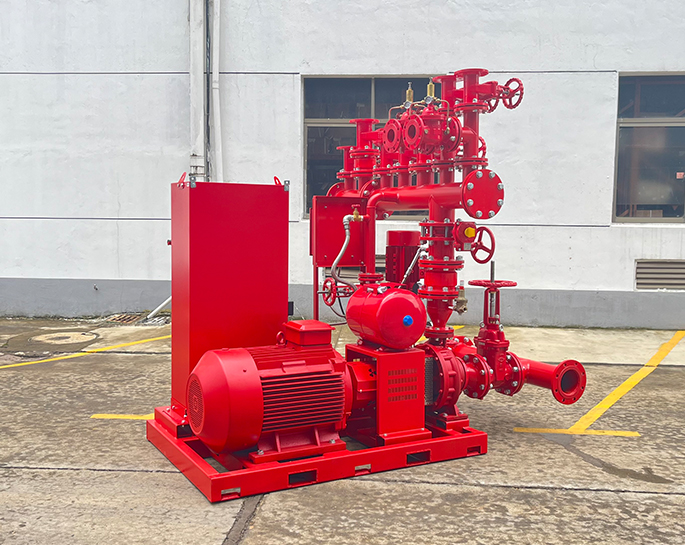What are some common issues with fire pumps?
Apr 10, 2024
Share:
Several common issues can arise with fire pumps, potentially compromising their effectiveness in firefighting scenarios. These issues can include:
1. **Lack of Maintenance**: Regular maintenance is crucial for ensuring the proper functioning of fire pumps. Neglecting maintenance can lead to various problems such as clogging, corrosion, or mechanical failure.
2. **Mechanical Failures**: Components of the fire pump, such as seals, bearings, or impellers, can wear out over time and eventually fail. Mechanical failures can result in reduced pump performance or complete pump failure.
3. **Clogging**: Debris or foreign objects in the water supply can clog the intake or impeller of the fire pump, reducing water flow and pressure. Regular inspection and cleaning of the pump intake are essential for preventing clogging issues.
4. **Corrosion**: Corrosion of pump components, particularly in environments with exposure to moisture or chemicals, can weaken the pump structure and lead to leaks or failures.
5. **Seal Leaks**: Leaks in the seals of the fire pump can allow water to escape, reducing pump efficiency and potentially causing damage to other components.
6. **Overheating**: Overheating of the pump motor or other components can occur due to factors such as excessive load, insufficient cooling, or poor ventilation. Overheating can lead to motor burnout or other damage if not addressed promptly.
7. **Electrical Issues**: Electrical problems such as faulty wiring, connections, or control panel malfunctions can disrupt the operation of electrically powered fire pumps.
8. **Water Supply Issues**: Inadequate water supply, either due to low water pressure, insufficient flow rate, or water source contamination, can hinder the performance of the fire pump.
9. **Vibration and Alignment Problems**: Improper installation or misalignment of the pump and motor can cause excessive vibration, leading to premature wear of components and reduced pump efficiency.
10. **Age and Obsolescence**: Older fire pumps may become outdated or obsolete, making it challenging to find replacement parts or support for maintenance and repairs.
Regular inspection, testing, and maintenance by qualified personnel are essential for identifying and addressing potential issues with fire pumps to ensure their reliability and effectiveness in firefighting operations.

1. **Lack of Maintenance**: Regular maintenance is crucial for ensuring the proper functioning of fire pumps. Neglecting maintenance can lead to various problems such as clogging, corrosion, or mechanical failure.
2. **Mechanical Failures**: Components of the fire pump, such as seals, bearings, or impellers, can wear out over time and eventually fail. Mechanical failures can result in reduced pump performance or complete pump failure.
3. **Clogging**: Debris or foreign objects in the water supply can clog the intake or impeller of the fire pump, reducing water flow and pressure. Regular inspection and cleaning of the pump intake are essential for preventing clogging issues.
4. **Corrosion**: Corrosion of pump components, particularly in environments with exposure to moisture or chemicals, can weaken the pump structure and lead to leaks or failures.
5. **Seal Leaks**: Leaks in the seals of the fire pump can allow water to escape, reducing pump efficiency and potentially causing damage to other components.
6. **Overheating**: Overheating of the pump motor or other components can occur due to factors such as excessive load, insufficient cooling, or poor ventilation. Overheating can lead to motor burnout or other damage if not addressed promptly.
7. **Electrical Issues**: Electrical problems such as faulty wiring, connections, or control panel malfunctions can disrupt the operation of electrically powered fire pumps.
8. **Water Supply Issues**: Inadequate water supply, either due to low water pressure, insufficient flow rate, or water source contamination, can hinder the performance of the fire pump.
9. **Vibration and Alignment Problems**: Improper installation or misalignment of the pump and motor can cause excessive vibration, leading to premature wear of components and reduced pump efficiency.
10. **Age and Obsolescence**: Older fire pumps may become outdated or obsolete, making it challenging to find replacement parts or support for maintenance and repairs.
Regular inspection, testing, and maintenance by qualified personnel are essential for identifying and addressing potential issues with fire pumps to ensure their reliability and effectiveness in firefighting operations.


.png)
.png)

.png)


